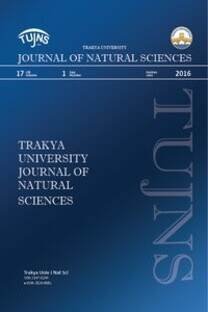Siklohekzan karboksilli asidin sodyum ve kobalt tuzlarını eldesi ve sodyum tuzunun antimikrobiyal aktivitesi
Son yıllarda geçiş metal naftenatlarının (karboksilatlarının) sentezi çok fazla uygulama alanına sahip olduğundan büyük öneme sahiptir. Bu tip anorganik sentezler yeni koordinasyon bileşiklerinin elde edilmesine ve incelenmesine neden olmuştur. Burada halkaya sahip karbon asitlerinin kompleks meydana getirmesini ve bunların basit karboksilatlardan farkını belirlemek için çalışmalar yapıldı. Naftenik asit (siklohekzan karboksilikasit) ile NaOH'in karşılıklı etkisiyle sodyum karboksilat elde edildi. Daha sonra yer değiştirme reaksiyonu ile kobalt naftenat sentezlendi. Kobalt karboksilatın optimal sentezi, iki basamaklı yer değiştirme reaksiyonu ile gerçekleşmiştir. Elde edilen asit ve naftenatların IR, NMR spektrumları ve kobalt naftenatın termogravimetrik analizi alınarak fiziksel, kimyasal özellikleri ve kristal yapısı incelenmiştir. Sodyum karboksilatın antimikrobiyal aktivitesi Gram-pozitif kok (Staphylococcus aureus), Gram-negatif basil (Escherichia colî) ve maya mantarında (Candida albicans) araştırılmıştır.
The synthesis of cycloheane carboxylic acid, its cobalt and sodium salts and antimicrobial activity of sodium salt
In the recent years, the synthesis of transition metals naphtenates became very important because of large application possibilities. Those types of inorganic synthesis become a reason for discovery and the study of new coordination compounds. The experiments are designed to make complex compounds of cyclic carbon acid and to study their differences from simple carboxylates. By using of naphthanic acid (cycloheksane carboxylic acid) and sodium hydroxide, sodium naphthenate is produced. Then applying substation reaction, cobalt naphthenate is synthesized. The optimal yields for cobalt naphthenate is obtained by a two step reaction. The physical and chemical properties and structural characteristics for acid and naphthenate are obtained by applying IR, NMR and termogravimetric analysis. In this study antimicrobial activity of sodium naphthenate was also investigated on Gram-positive cocci (Staphylococcus aureus), Gram-negative bacilli (Escherichia coli) and yeast (Candida albicans).
___
- 1 ABDULLAYEV AM. Nikel, Mangan ve Bakır naftenatların sentezi ve araştırılması, Doktora tezi, Bakü, 1967.
- 2 ABDULLAYEV AM. The Synthesis of Naphtenates, Moskow, p. 10 – 65, 1991.
- 3 BARATOVA SA., Naftenik asitlerin sodyum tuzunun arterial tansiyonu, aksırmaya ve canlı hayvan deri kapiler damarlarına etkisi, Alma- Ata, Hayvan Enstitüsü, 1492, 1982.
- 4 EFENDIYEV H., ALEKPEROV RA. Naftenik asitlerle uranyumun sulu çözeltiden ekstraksiyonu, Azerbaycan Kimya Dergisi, 2, 110-3, 1965.
- 5 FIRRIDO YM., SIPES IG., CARTER DE. “Absorption and disposition of cobalt naphtenate, Journal of Toxicologyc and Environmental, 58, 6, 383-395, 1999.
- 6 FOROŞ E., Büyük mekaniksel yükler için transmisyon yağlayıcılar, SRR (Patent), 88453, 1987.
- 7 GERLOCH M. Magnetism and Ligand-Field Analysis, Oxford University Press, Oxford, 1984.
- 8 HACKBART C., ACHAMBERS H., Methicillin resistant staphlococci, Genetics and resistance, Antimicrob Agents Chemother 33,991, 1989.
- 9 HELL C., MAYDINGER E., Ber Dtsch. Chem Yes., 7, 1216, 1874.
- 10 KAMDEM DP., CHOW P. The effect of pressure on retention and bending properties of copper naphthenate, Wood and science, 31, 2, 128-135, 1999.
- 11 KAZIMOV AM. Naftenik asitler esasında sentez edilmiş inhibitörler, Azerbeycan Petrol Kimyası, 1, 34-5, 1968.
- 12 KULIYEV AM. Naftenik asitlerinin tuzları esasında çok fonksiyonelli katkı maddelerinin eldesi ve yağlayıcılarda kullanılması, Azerpetrolneşr, 121, 1960.
- 13 KULIYEV A.M. Naftenik asitler, İzd. Kimya, 1965.
- 14 LAVERDIERRE M, WEISS K, RIVEST R, DELERME J, Trends in antibiotic resistance of staphlycocci over an eight year period: differences in the emergence of resistance between coagulase positive and coagulase negative staphylococci, Microbial Drug Res. 4,119, 1998.
- 15 LIPSTEYN RA. Petrolde vanadyum korrozyonunun önlenmesi için katkı maddelerinin eldesi, Teploenerjetika, 9, 19, 1964.
- 16 NAKONEÇNAYA MV. Petrolün tetkiki ve petrokimya, Respublic dergisi, 10, 25-28, 1973.
- 17 NATIONAL COMMITTEE FOR CLINICAL LABORA-TORY STANDARDS, Methods for dilution antimicrobial susceptibility tests for bacteria that grow aerobically, 4th. Ed. NCCLS document M7-A4 Villanova, Pennsylvanla, 1997.
- 18 NIYAZOV AN. Naftenik asitler, Ashabad: İzd., 1969.
- 19 PETROV DS., DANILOVIÇ Aİ., KABINOVIÇ AV. Petrol ve mineral yağların oksidasyonu ve elde edilen ürünlerin tekniksel uygulama alanları, Gostoptekizdat, 1933.
- 20 RIBAK BM. Naftenik asitler, Gostoptekizdat, 1948.
- 21 RJELSKAYA FR. Petrol ve Gaz tekniğinde yenilikler, Petrol ve petrokimya, 4, 15, 1962.
- 22 RUETTINGER WF., DISMUTES GC. Protonation and dehydration reactions of the manganese naphthenate, Inorganic Chemistry, 38, 6, 1036, 1999.
- 23 SANIN Pİ., NAMYOTKIN NS. Yağlayıcılar için katkı maddeleri, Gostoptekizdat, 107, 1946.
- 24 SERGIYENKO S.R. Yüksek-moleküllü Bileşikler, izd. Kimya, 304-327,1964.
- 25 SHANSON DC. Clinical relevence of resistance to fusidic acids in Staphylococcus aureus, J antimicrob Chemother, 25 (Suppl B),15, 1990.
- 26 SISKOVSKI BK. Kerosin fraksiyonunun oksidasyonundan sentetik asitlerin eldesi, Gostoptekizdat, 1954.
- 27 TÜRKYILMAZ M. Geçiş metallerinin halka yapılı karbok-silatlarının sentezi, yapısı, özellikleri ve uygulama alanlarının incelenmesi, Doktora tezi, T.Ü. Fen Bilimleri Enstitüsü, 2001.
- 28 VOLKANOVSKAYA GA. Naftenik asit tuzları saklayan doymuş polidivinilklorür kompozisyonu, Deri ve bant malzemeleri teknolojisi, 6T155, 21-22, 1982.
- 29 WOLFGANG K. Identification of polyciclic Naphtenic, mono and Pioromatic Crude Oil Carbocylic Asids, And chem., 2, 180-189, 1970.
- 30 ZYSKOWSKI J., KAMDEM DP. UV and IR charecterization of copper naphthenate, Wood and Science, 31, 4, 441-446, 1999
- ISSN: 1302-647X
- Yayın Aralığı: Yıllık
- Başlangıç: 2018
- Yayıncı: -
